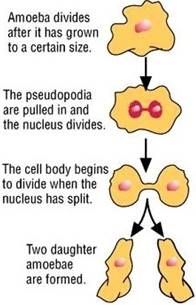Draw in sequence (showing the four stages), the process of binary fission in Amoeba.
Asexual reproduction is the primary form of reproduction for single-celled organisms such as the Achaea, bacteria, and protists. Many plants and fungi reproduce asexually as well. Asexual reproduction is a mode of reproduction by which offspring arise from a single parent, and inherit the genes of that parent only. The offspring will be the exact genetic copies of the parent.
New organisms are produced in rapid multiplication by the process of amitotic or mitotic divisions. Amitosis is the process by which a cell directly separates, as the nucleus and cytoplasm are directly cut in two. Mitosis is the process by which a cell, which has previously replicated each of its chromosomes, separates the chromosomes in its cell nucleus into two identical sets of chromosomes; each set will have its own new nucleus. It is a form of nuclear division.
Binary fission and budding are two common methods of asexual reproduction. Binary fission is found in unicellular organisms like Amoeba, Paramecium and Euglena, to name and few. Budding is found in Yeast and Hydra.
Binary fission in Amoeba
Amoeba is a shapeless tiny unicellular organism that has a porous cell membrane which encloses the cell organelles and cytoplasm. Amoeba reproduces by the common asexual reproduction method called binary fission. After replicating its genetic material through mitotic division, the cell divides into two equal sized daughter cells. The genetic material is also equally partitioned; therefore the daughter cells are genetically identical to each other and the parent cell. In this process, the nucleus of the Amoeba first divides to form two daughter nuclei by the process of Karyokinesis. After the nucleus has divided into two, the process of Cytokinesis takes place in which the cytoplasm in the mother cell divides into two daughter cells. This leads to the formation of the two daughter Amoebae cell having a nucleus and its own cell organelles.

Karyokinesis is the process of the division of the nucleus. It corresponds to the separation of the daughter chromosomes into two daughter nuclei. Karyokinesis is usually followed by Cytokinesis.
Cytokinesis is the process of the division of the cytoplasm. It corresponds to the separation of the daughter nuclei into two daughter cells. Cytokinesis occurs immediately after mitosis.